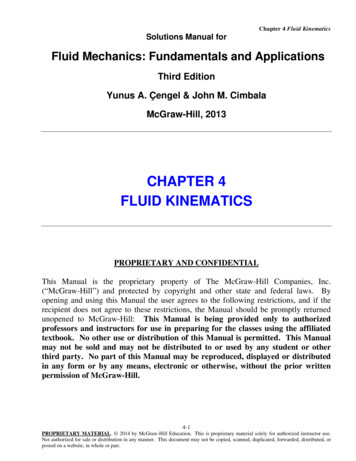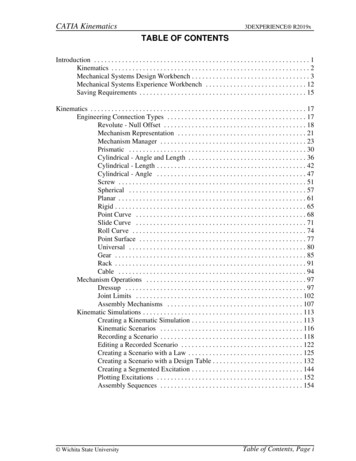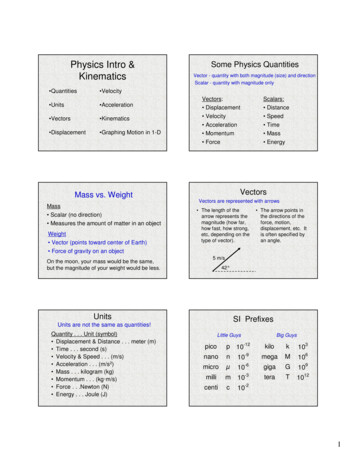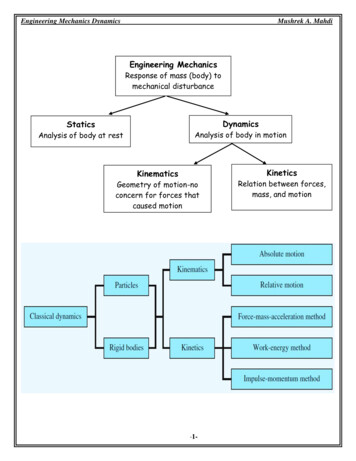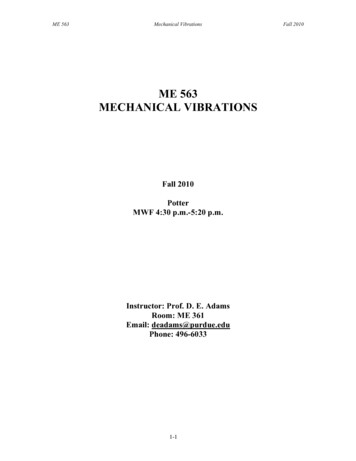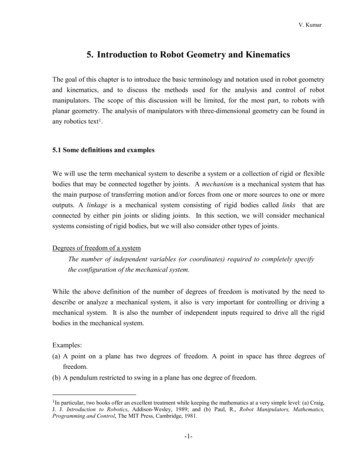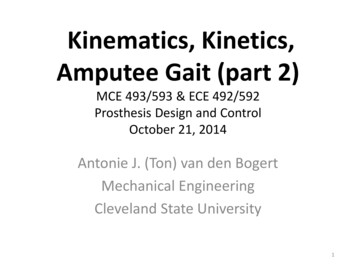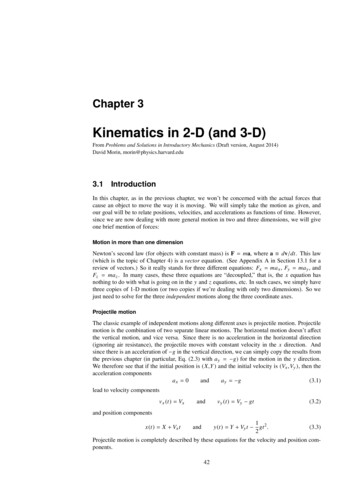
Transcription
Chapter 3Kinematics in 2-D (and 3-D)From Problems and Solutions in Introductory Mechanics (Draft version, August 2014)David Morin, morin@physics.harvard.edu3.1 IntroductionIn this chapter, as in the previous chapter, we won’t be concerned with the actual forces thatcause an object to move the way it is moving. We will simply take the motion as given, andour goal will be to relate positions, velocities, and accelerations as functions of time. However,since we are now dealing with more general motion in two and three dimensions, we will giveone brief mention of forces:Motion in more than one dimensionNewton’s second law (for objects with constant mass) is F ma, where a dv/dt. This law(which is the topic of Chapter 4) is a vector equation. (See Appendix A in Section 13.1 for areview of vectors.) So it really stands for three different equations: Fx ma x , Fy ma y , andFz maz . In many cases, these three equations are “decoupled,” that is, the x equation hasnothing to do with what is going on in the y and z equations, etc. In such cases, we simply havethree copies of 1-D motion (or two copies if we’re dealing with only two dimensions). So wejust need to solve for the three independent motions along the three coordinate axes.Projectile motionThe classic example of independent motions along different axes is projectile motion. Projectilemotion is the combination of two separate linear motions. The horizontal motion doesn’t affectthe vertical motion, and vice versa. Since there is no acceleration in the horizontal direction(ignoring air resistance), the projectile moves with constant velocity in the x direction. Andsince there is an acceleration of g in the vertical direction, we can simply copy the results fromthe previous chapter (in particular, Eq. (2.3) with a y g) for the motion in the y direction.We therefore see that if the initial position is (X,Y ) and the initial velocity is (Vx ,Vy ), then theacceleration componentsax 0anda y g(3.1)lead to velocity componentsv x (t) Vxandvy (t) Vy gt(3.2)and position components1y(t) Y Vy t gt 2 .(3.3)2Projectile motion is completely described by these equations for the velocity and position components.x(t) X Vx tand42
3.1. INTRODUCTION43Standard projectile resultsThe initial velocity V of a projectile is often described in terms of the initial speed v0 (we’ll use alowercase v here, since it looks a little nicer) and the launch angle θ with respect to the horizontal.From Fig. 3.1, the initial velocity components are then Vx v0 cos θ and Vy v0 sin θ, so thevelocity components in Eq. (3.2) becomev x (t) v0 cos θandvy (t) v0 sin θ gt,(3.4)v0v0 sinθθv0 cosθFigure3.1and the positions in Eq. (3.3) become (assuming that the projectile is fired from the origin, sothat (X,Y ) (0, 0))x(t) (v0 cos θ)tand1y(t) (v0 sin θ)t gt 2 .2(3.5)A few results that follow from these expressions are that the time to the maximum height, themaximum height attained, and the total horizontal distance traveled are given by (see Problem 3.1)t top v0 sin θ,gymax v02 sin2 θ2g,x max 2v02 sin θ cos θg v02 sin 2θg.(3.6)The last of these results holds only if the ground is level (more precisely, if the projectile returnsto the height from which it was fired). As usual, we are ignoring air resistance.Motion along a planeIf an object slides down a frictionless plane inclined at angle θ, the acceleration down the plane isg sin θ, because the component of g (the downward acceleration due to gravity) that points alongthe plane is g sin θ; see Fig. 3.2. (There is no acceleration perpendicular to the plane becausethe normal force from the plane cancels the component of the gravitational force perpendicularto the plane. We’ll discuss forces in Chapter 4.) Even though the motion appears to take placein 2-D, we really just have a (tilted) 1-D setup. We effectively have “freefall” motion along thetilted axis, with the acceleration due to gravity being g sin θ instead of g. If θ 0, then the g sin θacceleration along the plane equals 0, and if θ 90 it equals g (downward), as expected.More generally, if a projectile flies through the air above an inclined plane, the object’s acceleration (which is the downward-pointing vector g) can be viewed as the sum of its componentsalong any choice of axes, in particular the g sin θ acceleration along the plane and the g cos θacceleration perpendicular to the plane. This way of looking at the downward g vector can bevery helpful when solving projectile problems involving inclined planes. See Section 13.1.5 inAppendix A for further discussion of vector components.Circular motionAnother type of 2-D motion is circular motion. If an object is moving in a circle of radius r withspeed v at a given instant, then the (inward) radial component of the acceleration vector a equals(see Problem 3.2(a))v2.(3.7)ar rThis radially inward acceleration is called the centripetal acceleration. If additionally the objectis speeding up or slowing down as it moves around the circle, then there is also a tangentialcomponent of a given by (see Problem 3.2(b))at dv.dt(3.8)This tangential component is the more intuitive of the two components of the acceleration; itcomes from the change in the speed v, just as in the simple case of 1-D motion. The ar componentg cos θ θg sin θg sin θθFigure3.2g
CHAPTER 3. KINEMATICS IN 2-D (AND 3-D)44is the less intuitive one; it comes from the change in the direction of v. Remember that theacceleration a dv/dt involves the rate of change of the entire vector v, not just the magnitudev v . A vector can change because its magnitude changes or because its direction changes (orboth). The former change is associated with at , while the latter is associated with ar .It is sometimes convenient to work with the angular frequency ω (also often called the angular speed or angular velocity), which is defined to be the rate at which the angle θ around thecircle (measured in radians) is swept out. That is, ω dθ/dt. If we multiply both sides of thisequation by the radius r, we obtain rω d(rθ)/dt. But rθ is simply the distance s traveled alongthe circle,1 so the right-hand side of this equation is ds/dt, which is just the tangential speed v.Hence rω v ω v/r. In terms of ω, the radial acceleration can be written asar v2(rω) 2 ω2 r.rr(3.9)Similarly, we can define the angular acceleration as α dω/dt d 2 θ/dt 2 . If we multiplythrough by r, we obtain rα d(rω)/dt. But from the preceding paragraph, rω is the tangentialspeed v. Therefore, rα dv/dt. And since the right-hand side of this equation is just thetangential acceleration, we haveat rα.(3.10)We can summarize most of the results in the previous two paragraphs by saying that the“linear” quantities (distance s, speed v, tangential acceleration at ) are related to the angularquantities (angle θ, angular speed ω, angular acceleration α) by a factor of r:s rθ,v rω,at rα.(3.11)However, the radial acceleration ar doesn’t fit into this pattern.3.2 Multiple-choice questions3.1. A bullet is fired horizontally from a gun, and another bullet is simultaneously dropped fromthe same height. Which bullet hits the ground first? (Ignore air resistance, the curvatureof the earth, etc.)(a) the fired bullet(b) the dropped bullet(c) They hit the ground at the same time.3.2. A projectile is fired at an angle θ with respect to level ground. Is there a point in the motionwhere the velocity is perpendicular to the acceleration?YesNo3.3. A projectile is fired at an angle θ with respect to level ground. Does there exist a θ suchthat the maximum height attained equals the total horizontal distance traveled?YesNo3.4. Is the following reasoning correct? If the launch angle θ of a projectile is increased (whilekeeping v0 the same), then the initial vy velocity component increases, so the time in theair increases, so the total horizontal distance traveled increases.YesNo1This is true by the definition of a radian. If you take a piece of string with a length of one radius and lay it out alongthe circumference of a circle, then it subtends an angle of one radian, by definition. So each radian of angle is worthone radius of distance. The total distance s along the circumference is therefore obtained by multiplying the number ofradians (that is, the number of “radiuses”) by the length of the radius.
3.2. MULTIPLE-CHOICE QUESTIONS453.5. A ball is thrown at an angle θ with speed v0 . A second ball is simultaneously thrownstraight upward from the point on the ground directly below the top of the first ball’sparabolic motion. How fast should this second ball be thrown if you want it to collide withthe first ball? (a) v0 /2(b) v0 / 2(c) v0(d) v0 cos θ(e) v0 sin θ3.6. A wall has height h and is a distance ℓ away. You wish to throw a ball over the wall with atrajectory such that the ball barely clears the wall at the top of its parabolic motion. Whatinitial speed is required? (Don’t solve this from scratch, just check special cases. SeeProblem 3.10 for a quantitative solution.) (a) 2gh (b) 4gh (c) gℓ 2 /2h (d) 2gh gℓ 2 /2h (e) 4gh gℓ 2 /2hθθ3.7. Two balls are thrown with the same speed v0 from the top of a cliff. The angles of theirinitial velocities are θ above and below the horizontal, as shown in Fig. 3.3. How much farther along the ground does the top ball hit than the bottom ball? Hint: The two trajectorieshave a part in common. No calculations necessary!Figure(a) 2v02 /g3.3(b) 2v02 sin θ/g(c) 2v02 cos θ/g(d) 2v02 sin θ cos θ/g(e) 2v02 sin2 θ cos2 θ/gvelocity intothe page3.8. A racecar travels in a horizontal circle at constant speed around a circular banked track. Aside view is shown in Fig. 3.4. (The triangle is a cross-sectional slice of the track; the caris heading into the page at the instant shown.) The direction of the racecar’s accelerationisθ(a) horizontal rightward(side view)(b) horizontal leftwardFigure(c) downward along the plane3.4(d) upward perpendicular to the plane(e) The acceleration is zero.3.9. Which one of the following statements is not true for uniform (constant speed) circularmotion?(a)(b)(a) v is perpendicular to r.(b) v is perpendicular to a.(e)a 0(c) v has magnitude Rω and points in the r direction.(d) a has magnitude v 2 /R and points in the negative r direction.(e) a has magnitude ω2 R and points in the negative r direction.3.10. A car travels around a horizontal circular track, not at constant speed. The accelerationvectors at five different points are shown in Fig. 3.5 (the four nonzero vectors have equallength). At which of these points is the car’s speed the largest?(c)(d)(top view)Figure3.5
CHAPTER 3. KINEMATICS IN 2-D (AND 3-D)46(side view)(a)(e)(b)3.11. A bead is given an initial velocity and then circles indefinitely around a frictionless verticalhoop. Only one of the vectors in Fig. 3.6 is a possible acceleration vector at the given point.Which one?3.12. A pendulum is released from rest at an angle of 45 with respect to the vertical, as shownbelow. Which vector shows the direction of the initial acceleration?(d)(c)(a)(side view)Figure453.6(b)(c)aaa(d)a(e)a 03.13. A pendulum swings back and forth between the two horizontal positions shown in Fig. 3.7.The acceleration is vertical (g downward) at the highest points, and is also vertical (upward) at the lowest point.(a) There is at least one additional point where the acceleration is vertical.(side view)Figure3.7(b) There is at least one point where the acceleration is horizontal.(c) There is at least one point where the acceleration is zero.(d) None of the above3.3 ProblemsThe first three problems are foundational problems.3.1. A few projectile resultsOn level ground, a projectile is fired at angle θ with speed v0 . Derive the expressionsin Eq. (3.6). That is, find (a) the time to the maximum height, (b) the maximum heightattained, and (c) the total horizontal distance traveled.3.2. Radial and tangential accelerations(a) If an object moves in a circle at constant speed v (uniform circular motion), showthat the acceleration points radially inward with magnitude ar v 2 /r. Do this bydrawing the position and velocity vectors at two nearby times and then making useof similar triangles.(b) If the object speeds up or slows down as it moves around in the circle, then theacceleration also has a tangential component. Show that this component is given byat dv/dt.3.3. Radial and tangential accelerations, againA particle moves in a circle, not necessarily at constant speed. Its coordinates are givenby (x, y) (R cos θ, R sin θ), where θ θ(t) is an arbitrary function of t. Take two timederivatives of these coordinates to find the acceleration vector, and then explain why theresult is consistent with the ar and at magnitudes derived in Problem 3.2.3.4. Movie replica(a) A movie director wants to shoot a certain scene by building a detailed replica of theactual setup. The replica is 1/100 the size of the real thing. In the scene, a personjumps from rest from a tall building (into a net, so it has a happy ending). If thedirector films a tiny doll being dropped from the replica building, by what factorshould the film be sped up or slowed down when played back, so that the fallingperson looks realistic to someone watching the movie? (Assume that the motion isessentially vertical.)
3.3. PROBLEMS47(b) The director now wants to have a little toy car zoom toward a cliff in the replica (withthe same scale factor of 1/100) and then sail over the edge down to the ground below(don’t worry, the story has the driver bail out in time). Assume that the goal is tohave the movie viewer think that the car is traveling at 50 mph before it goes overthe cliff. As in part (a), by what factor should the film be sped up or slowed downwhen played back? What should the speed of the toy car be as it approaches the cliffin the replica?3.5. Doubling gravityA ball is thrown with speed v at an angle θ with respect to the horizontal ground. At thehighest point in the motion, the strength of gravity is somehow magically doubled. Whatis the total horizontal distance traveled by the ball?3.6. Ratio of heightsFrom the standard d gt 2 /2 expression for freefall from rest, we see that if the falling timeis doubled, the falling distance is quadrupled. Use this fact to find the ratio of the height ofthe top of projectile motion (point A in Fig. 3.8) to the height where the projectile wouldbe if gravity were turned off (point B in the figure). Two suggestive distances are drawn.BA3.7. Hitting horizontallyA ball is thrown with speed v0 at an angle θ with respect to the horizontal. It is thrownfrom a point that is a distance ℓ from the base of a cliff that has a height also equal to ℓ.What should θ and v0 be so that the ball hits the corner of the cliff moving horizontally, asshown in Fig. 3.9?3.8. Projectile and tubeFigure3.8lv0A projectile is fired horizontally with speed v0 from the top of a cliff of height h. Itimmediately enters a fixed tube with length x, as shown in Fig. 3.10. There is frictionbetween the projectile and the tube, the effect of which is to make the projectile deceleratewith constant acceleration a (a is a positive quantity here). After the projectile leaves thetube, it undergoes normal projectile motion down to the ground.θlFigure3.9v0xhlFigure3.10(a) What is the total horizontal distance (call it ℓ) that the projectile travels, measuredfrom the base of the cliff? Give your answer in terms of x, h, v0 , g, and a.(b) What value of x yields the maximum value of ℓ?3.9. Car in the mudA wheel is stuck in the mud, spinning in place. The radius is R, and the points on therim are moving with speed v. Bits of the mud depart from the wheel at various randomlocations. In particular, some bits become unstuck from the rim in the upper left quadrant,as shown in Fig. 3.11. What should θ be so that the mud reaches the maximum possibleheight (above the ground) as it flies through the air? What is this maximum height? Youmay assume v 2 gR.vRθFigure3.11
CHAPTER 3. KINEMATICS IN 2-D (AND 3-D)483.10. Clearing a wall(a) You wish to throw a ball to a friend who is a distance 2ℓ away, and you want the ballto just barely clear a wall of height h that is located halfway to your friend, as shownin Fig. 3.12. At what angle θ should you throw the ball?hθl(b) What initial speed v0 is required? What value of h (in terms of ℓ) yields the minimumv0 ? What is the value of θ in this minimum case?lFigureFigure3.123.11. Bounce throwA person throws a ball with speed v0 at a 45 angle and hits a given target. How muchquicker does the ball get to the target if the person instead throws the ball with the samespeed v0 but at the angle that makes the trajectory consist of two identical bumps, as shownin Fig. 3.13? (Assume unrealistically that there is no loss in speed at the bounce.)3.133.12. Maximum bounceA ball is dropped from rest at height h. At height y, it bounces elastically (that is, withoutlosing any speed) off a board. The board is inclined at the angle (which happens to be 45 )that makes the ball bounce off horizontally. In terms of h, what should y be so that the ballhits the ground as far off to the side as possible? What is the horizontal distance in thisoptimal case?A3.13. Falling along a right triangleIn the vertical right triangle shown in Fig. 3.14, a particle falls from A to B either alongthe hypotenuse, or along the two legs (lengths a and b) via point C. There is no frictionanywhere.baBC(side view)Figure3.14(a) What is the time (call it t H ) if the particle travels along the hypotenuse?(b) What is the time (call it t L ) if the particle travels along the legs? Assume that atpoint C there is an infinitesimal curved arc that allows the direction of the particle’smotion to change from vertical to horizontal without any change in speed.(c) Verify that t H t L when a 0.(d) How do t H and t L compare in the limit b a?(e) Excluding the a 0 case, what triangle shape yields t H t L ?3.14. Throwing to a cliffA ball is thrown at an angle θ up to the top of a cliff of height L, from a point a distance Lfrom the base, as shown in Fig. 3.15.Lv0θL(a) As a function of θ, what initial speed causes the ball to land right at the edge of thecliff?(b) There are two special values of θ for which you can check your result. Check these.Figure3.153.15. Throwing from a cliffvlN 4A ball is thrown with speed v at angle θ (with respect to horizontal) from the top of acliff of height h. How far from the base of the cliff does the ball land? (The ground ishorizontal below the cliff.)l3.16. Throwing on stairsA ball is thrown horizontally with speed v from the floor at the top of some stairs. Thewidth and height of each step are both equal to ℓ.dFigure3.16(a) What should v be so that the ball barely clears the corner of the step that is N stepsdown? Fig. 3.16 shows the case where N 4.(b) How far along the next step (the distance d in the figure) does the ball hit?
3.3. PROBLEMS49(c) What is d in the limit N ?(d) Find the components of the ball’s velocity when it grazes the corner, and then explainwhy their ratio is consistent with your answer to part (c).v03.17. Bullet and sphereA bullet is fired horizontally with speed v0 from the top of a fixed sphere with radius R, asshown in Fig. 3.17. What is the minimum value of v0 for which the bullet doesn’t touchthe sphere after it is fired? (Hint: Find y as a function of x for the projectile motion, andalso find y as a function of x for the sphere near the top where x is small; you’ll need tomake a Taylor-series approximation. Then compare your two results.) For the v0 you justfound, where does the bullet hit the ground?3.18. Throwing on an inclined planeYou throw a ball from a plane inclined at angle θ. The initial velocity is perpendicular tothe plane, as shown in Fig. 3.18. Consider the point P on the trajectory that is farthestfrom the plane. For what angle θ does P have the same height as the starting point? (Forthe case shown in the figure, P is higher.) Answer this in two steps:RFigurev03.17P(a) Give a continuity argument that explains why such a θ should in fact exist.(b) Find θ. In getting a handle on where (and when) P is, it is helpful to use a tiltedcoordinate system and to isolate what is happening in the direction perpendicular tothe plane.θFigure3.18Figure3.193.19. Ball landing on a blockA block is fired up along a frictionless plane inclined at angle β, and a ball is simultaneously thrown upward at angle θ (both β and θ are measured with respect to the horizontal).The objects start at the same location, as shown in Fig. 3.19. What should θ be in terms ofβ if you want the ball to land on the block at the instant the block reaches its maximumheight on the plane? (An implicit equation is fine.) What is θ if β equals 45 ? (You mightthink that we’ve forgotten to give you information about the initial speeds, but it turns outthat you don’t need these to solve the problem.)3.20. g’s in a washerA typical front-loading washing machine might have a radius of 0.3 m and a spin cycleof 1000 revolutions per minute. What is the acceleration of a point on the surface of thedrum at this spin rate? How many g’s is this equivalent to?3.21. Acceleration after one revolutionA car starts from rest on a circular track with radius R and then accelerates with constanttangential acceleration at . At the moment the car has completed one revolution, whatangle does the total acceleration vector make with the radial direction? You should findthat your answer doesn’t depend on at or R. Explain why you don’t have to actually solvethe problem to know this.3.22. Equal acceleration componentsAn object moves in a circular path of radius R. At t 0, it has speed v0 . From this pointon, the magnitudes of the radial and tangential accelerations are arranged to be equal at alltimes.(a) As functions of time, find the speed and the distance traveled.(b) If the tangential acceleration is positive (that is, if the object is speeding up), there isspecial value for t. What is it, and why is it special?
CHAPTER 3. KINEMATICS IN 2-D (AND 3-D)503.23. Horizontal accelerationA bead is at rest at the top of a fixed frictionless hoop of radius R that lies in a verticalplane. The bead is given an infinitesimal push so that it slides down and around the hoop.Find all the points on the hoop where the bead’s acceleration is horizontal. (We haven’tcovered conservation of energy yet, but use the fact that the bead’s speed after it has fallenthrough a height h is given by v 2gh.)3.4 Multiple-choice answers3.1. c This setup is perhaps the most direct example of the independence of horizontal andvertical motions, under the influence of only gravity. The horizontal motion doesn’t affectthe vertical motion, and vice versa. The gravitational force causes both objects to havethe same acceleration g downward, so their heights are both given by h gt 2 /2. The firedbullet might travel a mile before it hits the ground, but will still take a time of t 2h/g,just like the dropped ball.3.2. Yes At the highest point in the projectile motion, the velocity is sideways, and theacceleration is (always) downward.Remark: Since a (which is g g ŷ) is perpendicular to v at the top of the motion, the componentof a in the direction of v is zero. But this component is what causes a change in the speed (this isjust the at dv/dt statement). So dv/dt 0 at the top of the motion. This makes sense because onthe way up, the speed decreases (from a tilted v0 to a horizontal v0 cos θ); a has a component in thenegative v direction. And on the way down, the speed increases (from a horizontal v0 cos θ to a tiltedv0 ); a has a component in the positive v direction. So at the top of the motion, the speed must beneither increasing nor decreasing. That is, dv/dt 0. On the other hand, the vertical vy componentof the velocity steadily decreases (at a rate of g) during the entire flight, from v0 sin θ to v0 sin θ.3.3. Yes If θ is very small, then the projectile barely climbs above the ground, so the totalhorizontal distance traveled is much larger than the maximum height. In the other extremewhere θ is close to 90 , the projectile goes nearly straight up and down, so the maximumheight is much larger than the total horizontal distance. By continuity, there must exist anintermediate angle for which the maximum height equals the total horizontal distance. Asan exercise, you can show that this angle is given by tan θ 4 θ 76 .3.4. No The reasoning is not valid for all θ. For all θ, the reasoning is correct up until thelast “so.” The time t in the air does indeed increase as θ increases (it equals 2v0 sin θ/g).However, an additional consequence of increasing θ is that the v x velocity component(which equals v0 cos θ) decreases. The total horizontal distance equals v x t, so there arecompeting effects: increasing t vs. decreasing v x . If we invoke the standard result that themaximum distance is obtained when θ 45 (see the solution to Problem 3.1), we see thatfor θ 45 , the increase in t wins and the distance increases; but for θ 45 , the decreasein v x wins and the distance decreases.3.5. e The vertical velocity component of the first ball is v0 sin θ. If the second ball is thrownwith this speed, then it will always have the same height as a function of time as the firstball. The balls will therefore collide when the first ball’s horizontal position coincideswith the second ball’s (at the top of the parabolic motion).Remark: The initial location of the second ball on the ground is actually irrelevant. As long as itis thrown simultaneously with speed v0 sin θ, it can be thrown from any point below the parabolicmotion of the first ball, and the balls will still always have the same heights at any moment. Theywill therefore collide when the first ball’s horizontal position coincides with the second ball’s. If thecollision occurs during the second half of the parabolic motion, the balls will be on their way down.3.6. d The answer certainly depends on ℓ, because the speed must be very large if ℓ is verylarge. So choices (a) and (b) are ruled out. Alternatively, these two choices can be ruled
3.4. MULTIPLE-CHOICE ANSWERS51out by noting that in the h 0 limit, you must throw the ball infinitely fast. This is truebecause you must throw the ball at a very small angle; so if the speed weren’t large, theinitial vertical velocity would be very small, which means that the top of the parabolicmotion would occur too soon.In the ℓ 0 limit, you are throwing the ball straight up. And the initial speed in thiscase is the standard v 2gh. (This can be derived in many ways, for example by usingEq. (2.4).) So the answer must be (d).3.7. d When the top ball returns to the initial height (the height of the cliff), its velocity(both magnitude and direction) will be the same as the initial velocity of the bottom ball(speed v0 at an angle θ below the horizontal). So the trajectory from that point onwardwill look exactly the same as the entire trajectory of the bottom ball. So the difference inthe trajectories is just the symmetric parabola that lies above the initial height. And fromEq. (3.6) we know that the horizontal distance traveled in this part is 2v02 sin θ cos θ/g.Remark: The first three choices can be eliminated by checking limiting cases. The answer must bezero in both the θ 0 case (the trajectories are the same) and the θ 90 case (both balls travelvertically and hence have the same horizontal distance of zero). So the answer must be (d) or (e).But it takes the above reasoning to show that (d) is correct.3.8. b The acceleration has magnitude v 2 /r and points toward the center of the circularmotion. Since the car is traveling in a horizontal circle, the radial direction is to the left.So the acceleration is horizontal leftward.Remark: As long as we are told that the racecar is undergoing uniform (constant speed) circularmotion, there is no need to know anything about the various forces acting on the car (which happento be gravity, normal, and friction; we’ll discuss forces in Chapter 4). The acceleration for uniformcircular motion, no matter what the cause of the motion, points radially inward with magnitude v 2 /r,period.3.9. c The velocity v points in the tangential, not radial, direction. The other four statementsare all true.Remark: If you want to consider non-uniform (that is, changing speed) circular motion, then onlystatement (a) is always true. The acceleration can now have a tangential component, which ruins(b), (d), and (e). And statement (c) is still incorrect.3.10. c The radial component of the acceleration has magnitude ar v 2 /r. So the largestspeed v corresponds to the a with the largest (inward) radial component, which is choice(c).Remark: Note that the tangential component of the acceleration, which is at dv/dt, has nothing todo with the instantaneous value of v, which is what we’re concerned with in this question. A largeat component (as in choices (a), (b), and (d)) does not imply a large v. On the other hand, a zero arcomponent (as in choices (a) and (e)) implies a zero v.3.11. d The acceleration is the vector sum of the radially inward ar v 2 /r component and thetangentially downward at g sin θ component, where θ 0 corresponds to the top of thehoop. (This is just the component of g that points in the tangential direction.) Only choice(d) satisfies both of these properties. Choice (e) is the trickiest. The acceleration can’t behorizontal there, because both ar and at have downward components. There is a point ineach lower quadrant where the acceleration is horizontal, because in the bottom half of thecircle, ar has an upward component which can cancel the downward component of at attwo particular points.Remark: Since the radial ar v 2 /r component always points radially inward, the acceleration vectorin any arbitrary circular motion can never
Chapter 3 Kinematics in 2-D (and 3-D) From Problems and Solutions in Introductory Mechanics (Draft version, August 2014) David Morin, morin@physics.harvard.edu 3.1 Introduction In this chapter, as in the previous chapter, we won't be concerned with the actual forces that
